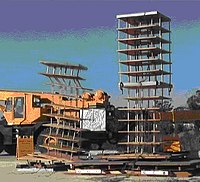
Photo from wikipedia
Friction control systems have been widely used as one of the efficient and cost effective solutions to control structural damage during strong earthquakes. However, the height-wise distribution of slip loads… Click to show full abstract
Friction control systems have been widely used as one of the efficient and cost effective solutions to control structural damage during strong earthquakes. However, the height-wise distribution of slip loads can significantly affect the seismic performance of the strengthened frames. In this study, a practical design methodology is developed for more efficient design of friction wall dampers by performing extensive nonlinear dynamic analyses on 3-, 5-, 10-, 15-, and 20-story RC frames subjected to seven spectrum-compatible design earthquakes and five different slip load distribution patterns. The results show that a uniform cumulative distribution can provide considerably higher energy dissipation capacity than the commonly used uniform slip load pattern. It is also proved that for a set of design earthquakes, there is an optimum range for slip loads that is a function of number of stories. Based on the results of this study, an empirical equation is proposed to calculate a more efficient slip load distribution of friction wall dampers for practical applications. The efficiency of the proposed method is demonstrated through several design examples.
Journal Title: Earthquake Spectra
Year Published: 2017
Link to full text (if available)
Share on Social Media: Sign Up to like & get
recommendations!